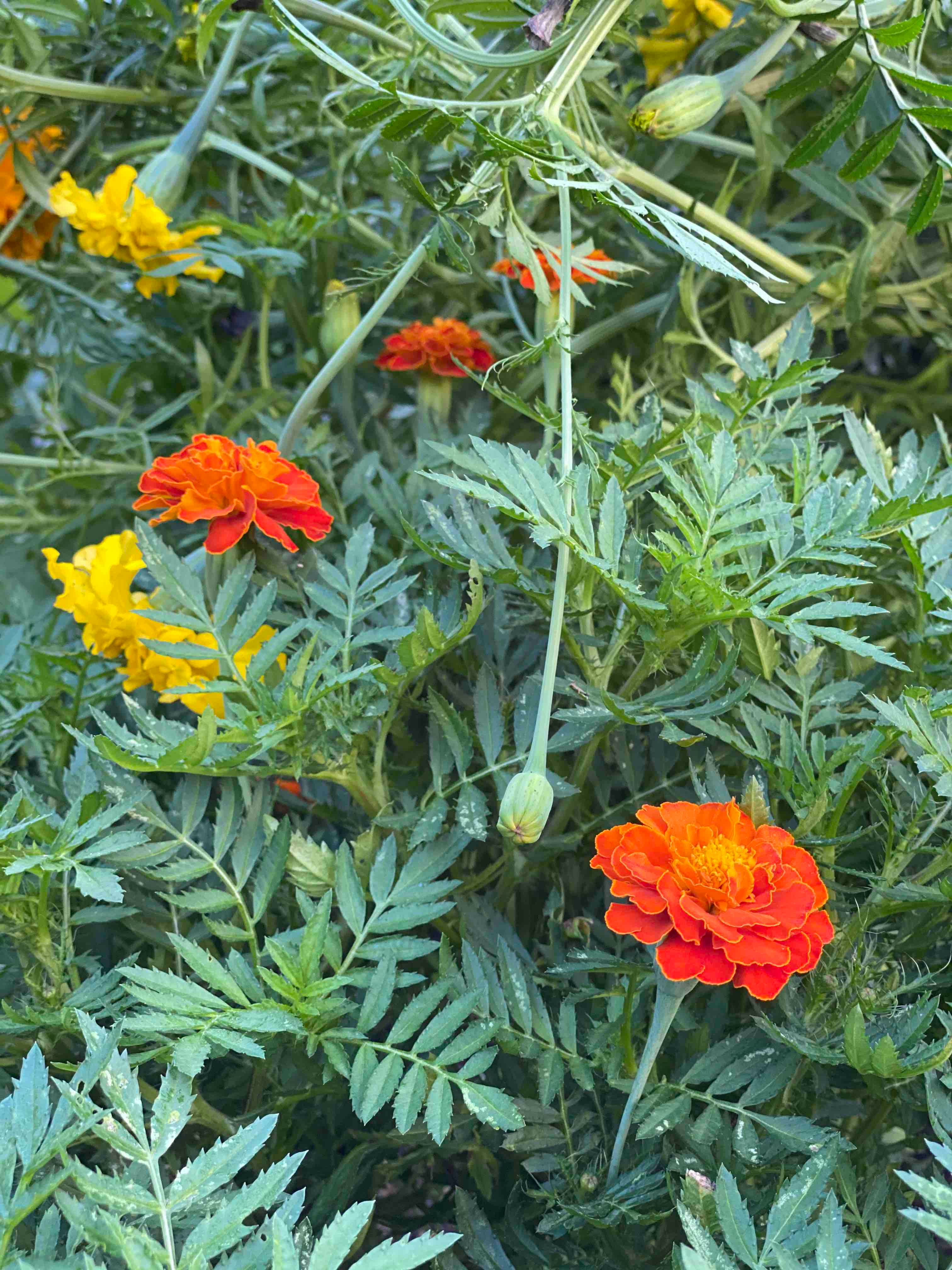Planning Your Garden and Companion Planting
planning your garden and companion planting
What do I plant, where, and how many? Many plants actually grow better together! Growing supporting plants together is called companion planting.
what do i plant, where, how many?
Planning and planting a garden bed is my favorite gardening activity. I get to be creative, get my hands dirty, and find ways for vegetables and flowers grow bigger and stronger together.
It's true -- many plants actually grow better together! Growing supporting plants together is often called companion planting or interplanting. Plants are companions if they actively support another plant's growth through enriching the soil, deterring pests, or otherwise supporting plant growth. Plants can also be grown together when they use different amounts of key nutrients, needing different amounts of sunlight, or occupying different space in or above the soil. It helps use garden space efficiently, and ideally improves flower and vegetable production and decreases pests problems Interplanting not only improves the heath of your plants, it can also allow you to use more space within your garden. It can also be simply beautiful.
Beneficial companion planting has a long and rooted history in various indigenous cultures around the world. One form of companion planting you may be familiar with is called Three Sisters. Over 5,000 years ago, indigenous groups in the Americas domesticated squash, maize (corn), and beans, and developed the Three Sisters method of companion planting. These three plants are grown together in the same spot. The corn serves as a pole for climbing, beans fix nitrogen to make it available for the squash and corn to grow, and squash leaves grow large and provide shade to the soil, holding moisture.
Not only did these plants support one another, all together they created a complete food with nutrients essential to human growth and thriving, including fatty acids and all nine essential amino acids. One of the largest indigenous cities in the Americas, knowns as Cahokia, grew in large part due to a surplus of food made available by the Three Sister growing method. The Mississipian and Mvskoke cultures grew and thrived there for almost 1,000 years. Around 1600, white Europeans colonized the city and its people and introduced disease. (Wikipedia - Three Sisters (Agriculture))'
A lot of essential organic gardening knowledge like companion planting and natural dye methods still used today can be traced back to indigenous practices. Garden planning and interplanting go hand-in-hand in my organic gardening practice, so this post will talk about both.
Let's get planting!

Step 1: gather your transplants and seeds
First, purchase or start your transplants from seed, and sort out which plants you will seed directly into your garden bed. I recommend having all transplants ready to go before direct seeding in the same bed.


Step 2: SELECT A PRIMARY PLANT FOR YOUR GARDEN BED
To make garden planning and interplanting easy, I recommend first selecting one primary plant for your garden bed. This may be tomatoes, peppers, squash, herbs, or a dye plant like indigo or cosmos. Your garden bed can be any size, or even a large pot.
Step 3: SELECT A SECOND PLANT FOR YOUR GARDEN BED
After selecting your primary plant, check out this guide on companion planting from the Farmer's Almanac. I also refer to this guide from Burpee seeds. Do you have other transplants or seeds that will grow well with your primary plant? Put them together in a group to start planning.
Step 4: SELECT A THIRD PLANT FOR YOUR GARDEN BED
After selecting your second plant, look at the guides to see if there is a third plant that may grow well with your first two. This is optional, but I do find that there are many plants that will do well together. You do not need to stop at 2 or 3, but this will keep it manageable.
It's ok if your plants aren't listed directly together, like lettuce and tomatoes. As long as they do not stunt growth or otherwise cause problems that you need to keep the plants away from one another, you can grow them together.
You can determine what plants are 'enemies' to one another using the guides linked in Step 3. For example, tomatoes and potatoes can be harmed by the same diseases, and should be kept separate. Onions stunt the growth of beans.
Step 5: lay out your transplants and seeds together
Here's the fun part. Now that you have your chosen plants, you can test them out together in the same bed. First, place your primary plant (or stand-in objects to represent the plant, if you are planting from seed) in the bed at the required distance apart. For example, tomatoes usually need to be planted at least 18 inches apart to ensure each tomato plant has enough space.
How many primary plants to put in your bed depends entirely on the size of the bed and how far apart they must be planted. You may have more than one row of your primary plant, as long as they are the required distance apart.
Now, place your second plant (or object stand in) in-between your primary plants. Make sure these plants are the required distance apart from one another. For example, basil must be at about 18 inches apart from each other.
Here's where it gets more interesting. Even though your tomato plants need to be 18 inches apart from one another, and your basil needs to be 18 inches apart, your tomato and basil plants to do need to be 18 inches apart form each other. This is how interplanting can help you use your garden space more efficiently, growing twice or even three times as much in a garden bed.
In general, I cut the distance in half, and that is how far apart I will plant a something from its companion plant. This is based on my garden experience, but may or may not work for you. So, I plant basil in between my tomatoes. Each tomato plant is 18 inches apart, each basil plant is 18 inches apart, and each tomato plant is about 9 inches from each basil plant.
Finally, place your third plant (or object stand in) in your garden bed. In between rows of tomatoes and basil, I've planted 2 rows of lettuce. The tomato plants shade the lettuce as they grow in a hot climate, improving the growth of lettuce without harming the growth of tomatoes.






Step 6: plant!
Now that you planned out your garden space, get ready to plant! If you're new to transplanting seedlings, check out this post this post. First, transplant all seedlings into your bed. Then direct seed any seeds. If you seed before transplanting, you may trample them or disturb them in the process. Seeds should be planted at the depth and spacing recommended in the packet instructions.
Example Interplanted Beds:
- Cherokee purple tomatoes + Italian basil + lettuce + french marigolds
- Rosella tomatoes + purple basil + lettuce + french marigolds
- Sweet peppers + acorn squash + marigolds
- Eggplant + bush beans + marigolds
- Shades of gold marigold + dyers chamomile
- Kale + banana peppers + mustards + tomato
- Sugar snap peas + kale + mustards
- Okra + shishito peppers + cucumber


OPTIONAL: GARDEN ADD ONS
I try to fill my garden beds as much as possible without over crowding them. Sometimes I'll plant a random extra lettuce or tomato or flower in with other plants. I love a strong, diverse garden forest! Get creative and don't worry about staying in the lines.
One thing I always do is plant french marigolds along the outside of my vegetable garden beds. Marigolds prevent nematodes for tomatoes and eggplant, and beetles and other bugs for cucumbers, squash, beans, lettuce, and other vegetables. French marigolds typically stay compact, less than one foot tall, making them ideal for the edges of a garden bed. This dye plant can be your your vegetable garden best friend!


stand alone plants
If your plant does not play well with other plants and needs it's own bed, or you only want one plant in your bed, you can still map out your garden the same way as companion planting.
Instead, you'll measure out how far apart each plant must be, and dig your holes or place a plant or marker at each spot accordingly. You can plant/seed them in straight line rows, or staggered/diagonal rows, as long as the plants are the recommended distance apart.
I direct seeded sunflowers, black knight scabiosa, safflower, zinnias in their own beds. I have a bed dedicated to indigo transplants alone.
is it too late to plant?
In most places, if it's still warm outside, no! Get your garden started! If you started planting in April, you'll be seeing fruit by June or July.
But planting can happen over the course of the growing season. Check out when your area gets the first frost. If you have about 3 months until then, go ahead and get growing with summer plants. Most vegetables and flowers will produce in 90 days or less, and will continue producing until the first. frost.
If you have less time than that, focus on vegetables and flowers that produce in a short amount of time, like lettuce, basil, peas and beans. Or, if you're getting started late in the summer, focus on fall frost resistant crops like winter squash, snap peas, kale, mustard, onion, broccoli, Brussels sprouts, or other cool-weather crops.








Leave a comment